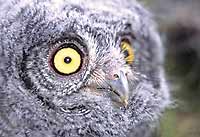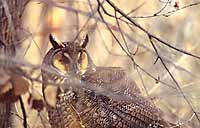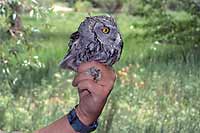.
February marks the transition from winter to spring in Canyon Country; never mind the traditional calendar hanging in the kitchen. Though winter’s icy fingers may still reach into March and even April, spring is nipping at winter’s heels.
 Perhaps it is the greening of grasslands or the appearance of wildflowers like Parry’s lomatium that signals the change. Maybe it’s the movement of yellow-rumped warblers, those early harbingers of spring, passing through on their way to northern breeding grounds. To me, the transition rests on the nocturnal ramblings of owls, those denizens of the dark, that have starting hooting to mark their territories and attract their mates in the dark hours of February.
Perhaps it is the greening of grasslands or the appearance of wildflowers like Parry’s lomatium that signals the change. Maybe it’s the movement of yellow-rumped warblers, those early harbingers of spring, passing through on their way to northern breeding grounds. To me, the transition rests on the nocturnal ramblings of owls, those denizens of the dark, that have starting hooting to mark their territories and attract their mates in the dark hours of February.
Amongst the owls, great horned owls are usually the first species to start nesting in late winter. They’ve been calling and setting up territories since November or December, and may even be sitting on eggs in February. These magnificent owls are best known for their deep, hoots that sound like “Who’s Awake? Me, too.”
The great horned owls with their large size and massive ear tufts are easily identified, they are not alone in the nocturnal scheme. Long-eared, barn, and Western screech-owls are three other owls that one might encounter during an “owl prowl” in February.
 Long-eared owls resemble great horned owls in that they too have long ear tufts. Though these tufts aren’t their ears – the ear openings are located asymmetrically on the sides of the head – they do help the owl blend into its surroundings when disturbed. And just because the long-eared is an owl doesn’t mean that it is immune to predation by their larger cousins.
Long-eared owls resemble great horned owls in that they too have long ear tufts. Though these tufts aren’t their ears – the ear openings are located asymmetrically on the sides of the head – they do help the owl blend into its surroundings when disturbed. And just because the long-eared is an owl doesn’t mean that it is immune to predation by their larger cousins.
Barn owls, though not common in Canyon Country, are a classic nocturnal predator that prey upon small rodents and rats with uncanny hunting abilities. These owls have been tested to hunt in 100% darkness with surprising efficiency. Throw in a little moonlight and a mouse or vole doesn’t stand a very good chance. Besides their hunting proficiency, barn owls have a heart-shaped facial disk that sets them apart from all other North American owls.
 Though all three of these owls may be heard within the City limits, Western screech-owls are the best adapted to life in town. These small owls with tiny ear tufts nest in tree cavities or even owl boxes in town. They prey upon small rodents and birds, and seem to prefer nesting in cottonwood trees throughout town. Their call is a series of shallow hoots that ends in a rapidly, descending progression. Because of their nocturnal nature and cryptic coloration, these owls may hang out in town and not be noticed by anyone except the owl prowler.
Though all three of these owls may be heard within the City limits, Western screech-owls are the best adapted to life in town. These small owls with tiny ear tufts nest in tree cavities or even owl boxes in town. They prey upon small rodents and birds, and seem to prefer nesting in cottonwood trees throughout town. Their call is a series of shallow hoots that ends in a rapidly, descending progression. Because of their nocturnal nature and cryptic coloration, these owls may hang out in town and not be noticed by anyone except the owl prowler.
What also works in one’s favor during February is the early onset of evening. Darkness arrives at a reasonable hour, not 9:30 pm such as in the summer. This gives the owler an opportunity to go out and listen for the owls at a reasonable hour, and not have to spend a really late night prowling for owls. And of the 13 owls that occur in Utah, an owler could locate about 50% of these in February. Not bad odds for hooting around in the dark.